Apr 11, 2014 | advice, coins, security, technology
 Computer and online security has been a topic for the news lately. This was because of a mistake made in software that was being used to try to keep your password from being seen by criminal hackers was making it visible to those criminals. In the wake of the news, the Doug Davis of the Numismatic Crime Information Center sent out a message to his list of contacts that had one central message for every dealer and collector:
Computer and online security has been a topic for the news lately. This was because of a mistake made in software that was being used to try to keep your password from being seen by criminal hackers was making it visible to those criminals. In the wake of the news, the Doug Davis of the Numismatic Crime Information Center sent out a message to his list of contacts that had one central message for every dealer and collector:
Shooting simple photos from your smart phone or personal camera can lead criminals right to your location… with pinpoint accuracy using GPS satellites.
You might have heard the term “metadata” in the news in the context of its collection by the National Security Agency. For those who do not know what metadata is, think of it as a description of the data. Think about an exhibit in a museum. The exhibit contains several artifacts arranged in a certain way to try to tell a story. But the story is incomplete because a little more information is needed to put it into context. But the information cannot be shown as an artifact in the exhibit, so the person setting up the exhibit adds a description added to the exhibit to make it more understandable. That description would be the metadata to the exhibit.

Example of what you can find out about your image in the file’s Properties under Windows
Modern cameras, cameras built into smartphones, and even some memory cards that can be inserted into older cameras can determine where you are located and record that in the metadata in the picture you take. And contrary to what you have read, new technologies do not have to use the Global Positioning System (GPS) to figure out where you are located. There are services that use WiFi to record your position. It is called WiFi Positioning System (WPS). Basically, WPS determines where it is located and communicates that to WiFi connected services so that it could be used to determine your location.
I know geotagging can be a lot of fun. A few years ago when my wife and I drove from Portland, Maine to Canada, I had taken pictures of the scenery along the way hoping to find a moose. After all, how can you go through the woods of Maine without seeing a moose?! When I loaded the pictures on my Mac in iPhoto, it was fun to see the plot of where the pictures were taken on the built-in map. I was able to follow the road into Canada just based on the geocodes.
What I did not do is post those pictures while on the road. Aside from the lack of cellular connectivity, posting those pictures would advertise to evil doers that I was not home and too far away to do anything.
If you take geocoded pictures of your coins and post them online, whether it you are posting them to a social media site or a discussion forum, you are advertising where the coin is located. This might not be a problem if you collection consists of what dealers would call ordinary or common coins. But if that 1937-D Buffalo nickel has only three legs, that geocoded picture announces that you have at least one high value coin that someone might want to acquire through less than legal means.
The problem is that I love to see pictures of interesting coins. This is one of the reasons I love Pinterest. Aside from sharing my own picture, Pinterest allows me to pin coin images from around the Internet to create virtual scrapbooks. Do you have an interesting coin? I want to see it. Different types of tokens and medals are excellent artwork.
However, when you take the pictures of your prized collection, make sure you turn off geotagging!
Unfortunately, I cannot tell you how to do it on every camera because the process is different. To help, I found the following two articles that provides an overview of how to turn off geotagging on the common smartphones:
- “How to Disable Geotagging on Your iPhone, Android Phone or Blackberry”
- “How to disable a smart phone’s geotagging feature”
For other cameras, you need to find the manual that came in the box to figure out how to do this.
In the meantime, stay safe online and let’s see those beautiful coins!
Apr 10, 2014 | coins, commemorative, commentary, legislative, policy, US Mint
 Amongst all of the noise on Capitol Hill, the one area where no noise has been made is in the numismatic arena. For the last three months there has been no bill introduced, heard in committee, or acted on by either chamber of congress. Although there have been some hearings on a few issues, the last numismatic-related bill that had any congressional action was the introduction of the Pro Football Hall of Fame Commemorative Coin Act, S. 1842, introduced by Sen. Rob Portman (R-OH) in December.
Amongst all of the noise on Capitol Hill, the one area where no noise has been made is in the numismatic arena. For the last three months there has been no bill introduced, heard in committee, or acted on by either chamber of congress. Although there have been some hearings on a few issues, the last numismatic-related bill that had any congressional action was the introduction of the Pro Football Hall of Fame Commemorative Coin Act, S. 1842, introduced by Sen. Rob Portman (R-OH) in December.
This type of inactivity is unusual for congress. Regardless of party, congress is always looking to curry favor with their constituents and groups associated with their constituents by introducing commemorative coin legislation. Over the last few congresses (a two-year term), there will be over 40 coin-related bills that die in committee where very few even get a cursory hearing.
This does not mean there will be no commemorative coins in the near future. Now, the U.S. Mint has issued the Civil Rights Act of 1964 Silver Dollar and National Baseball Hall of Fame commemoratives. In fact, the Baseball Hall of Fame coins are so popular that the gold option has sold out of its 50,000 statutory mintage limit.
As an aside, a friend pointed out that the U.S. Mint did not bring 50,000 gold coins to the Whitman Baltimore Expo and wondered how many of those coins were purchased by baseball’s owners and members of the Baseball Hall of Fame. It would be interesting to see the effect of organized baseball on the sale of these coins.
In 2015, the U.S. Mint is scheduled to release a March of Dimes Commemorative Silver Dollar commemorative coin. Founded in 1938 by President Franklin D. Roosevelt to combat polio, the March of Dimes changed its mission to combating birth defects after the discovery of the polio vaccine by Dr. Jonas Salk in 1954. Salk’s work was supported by the organization.
Also on the schedule for 2015 is the United States Marshals Service 225th Anniversary commemorative coin series. The Marshal Service commemoratives will include a gold $5, silver dollar, and clad half-dollar coins. I do not think this will be as popular as the 2005 Marine Corps 30th Anniversary commemorative coins.
Officially, the 2016 scheduled commemorative will be the Mark Twain Commemorative coin program that will only include gold $5 and silver dollar coins. However, considering Twain’s mindset about being famous, I think he would be amused by having a commemorative coin made in his honor. I might call it the “Mark Twain Amusement commemorative.”
The only other commemorative coin with legislation that has passed congress and signed by the president is the 2017 Lions Clubs International Century of Service Silver Dollar.
Given the law says that there will be no more than two commemorative coin series per year (31 U.S.C. §5112(m)); and given that the next time only one commemorative coin is scheduled to be issues is in 2016, there is plenty of time for congress to do “something” and pass one of the bills that is currently waiting for their action.
Apr 5, 2014 | Baltimore, coins, commemorative, gold, silver, US Mint, video
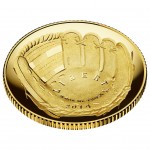
2014 National Baseball Hall of Fame Commemorative Proof $5 gold coin obverse
It has been speculated that the U.S. Mint will strike more coins than the law (Public Law 108–291 [PDF]) allows on order from the Secretary of the Treasury. No official decision has been announced by either the U.S. Mint or the Department of the Treasury. However, it is questioned whether it is legal for the Secretary to make this decision unilaterally or requires an act of congress. There seems to be evidence that someone had previously approved an increase for the 2005 Marine Corps Commemorative dollar, but there is no authoritative source for proof.
Collectors who have contacted me are not happy with the U.S. Mint. Many believe that the high limit (50 coins per “household”) was too high. When I posted images of the graded baseball coins, several commented that they felt that dealers “abused” their access to the immediate supply of coins that were available in the U.S. Mint booth at the Whitman Baltimore Expo that many collectors did not have a fair chance.
None of my correspondents would bemoan a dealer’s ability to make money on the secondary market. But to do so by taking advantage of the U.S. Mint’s inability to manage its market as the lone producer of U.S. commemorative coins was considered excessive by many. Although I sympathized with their point of view since I could not purchase one for my collection, I questioned whether the U.S. Mint has an obligation to just sell the coins or satisfy market forces. But as many pointed out, the U.S. Mint is a government agency and has a responsibility to the people of the United States and not just the corporations.
While at the Whitman show I spoke with one of the U.S. Mint employees who said that they should have limited the number of coins someone can purchase at one time. Although they did enforce lower limits on the supply of coins sold on Saturday, the damage had been done leaving collectors to scramble to buy the coins on the secondary market or order them online. Those of us who order the coins from the U.S. Mint online catalog will have to wait until June 21, according to the notice sent to me. However, the website is saying that the proof dollar is backordered until July 7 while the clad proof half-dollar is will be available on April 10.
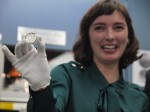
Cassie McFarland holds up Baseball Hall of Fame Commemorative Dollar with her design
We are talking about baseball, America’s pastime. America’s game. Regardless of the accepted story of its founding, it is generally accepted that Major League Baseball was founded in 1869 making it the oldest organized league in North America. Not only was the coin released just before Opening Day for 2014, but the National Baseball Hall of Fame and Major League Baseball have been promoting this coin since the bill was signed.
To even hint that this was going to be a situation like the failure of the 2013 Girl Scout Commemorative would be very short sighted and foolish.
Maybe the U.S. Mint should review its sales processes than chase after pattern coins.
In the mean time, the U.S. Mint published a B-Roll for the National Baseball Hall of Fame Commemorative.
Coin image and B-Roll footage courtesy of the U.S. Mint.
Image of Cassie McFarland courtesy of the
San Francisco Examiner.
Mar 31, 2014 | Baltimore, coins, quarter, shows, tokens
As with every show I attend, I try to find something neat. Something a little different. Something to show you that you can enjoy collecting numismatics that do not have to be plugged into a blue folder, a brown album, or entombed in a plastic case by a grading service. These are great items that have meaning and, for the most part, are affordable.
My find from the Spring 2014 Whitman Baltimore Expo was not discovered while walking the bourse floor. It was an opportunity that came available during the board meeting for the Maryland State Numismatic Association. One of our Board members is Ed Craig who is also president of the Maryland Token and Medals Society. As part of the meeting, Ed showed a limited edition elongated quarter that Maryland TAMS produced to commemorate the 200th Anniversary of the Battle of Baltimore and the writing of the poem “The Defence of Fort McHenry” by Francis Scott Key.
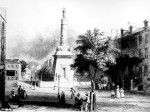
An 1838 lithograph of the Battle Monument in Baltimore
When they rolled the quarter to create the design, it was imprinted on the obverse of the quarter. You can see the Fort McHenry quarter design through the flattened reverse.
I will be wearing the one I purchased this August at the World’s Fair of Money in Chicago.
Maryland TAMS is making a very limited number of these sets available for $10 each. If you cannot pick up your set, they will ask you to pay postage to mail it to you. If you are interested contact Maryland TAMS through their website at mdtams.org.
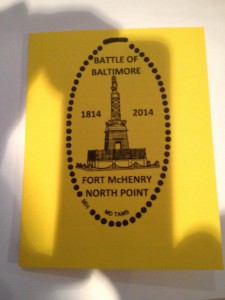
Cover of the Maryland Token and Medal Society souvenir card.
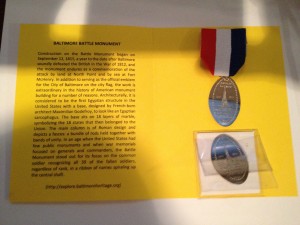
Cover of the Maryland Token and Medal Society souvenir card.
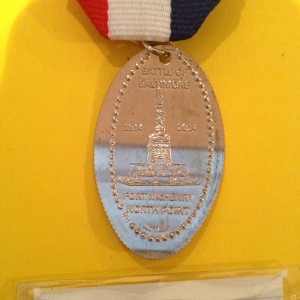
Closeup of the elongated quarter that is part of the Maryland Token and Medal Society souvenir card.
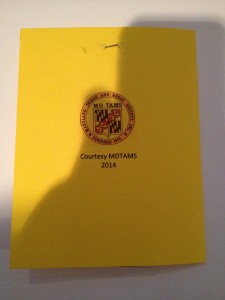
Back cover of the Maryland Token and Medal Society souvenir card.
Click on images to see larger versions.
Mar 30, 2014 | Baltimore, coins, commemorative
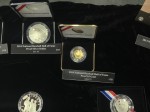
Display of the National Baseball Hall of Fame Commemorative Coins at the U.S. Mint booth
With news coverage that covered almost every media outlet because of its unique curved design, the U.S. Mint invited Baltimore Orioles Hall of Famer Brooks Robinson to their booth at the Baltimore Convention Center on Thursday, March 27. Nothing gets the attention of the local Baltimore market more than bringing in a popular former Orioles player. Only Cal Ripkin, Jr. would have given them more attention and probably an even bigger draw.
By early Friday afternoon, when I was able to arrive to the show, the U.S. Mint was sold out of all options, including the uncirculated coins. With the plant manager of the Philadelphia mint present, he was able to order more coins to be delivered to the convention center for Saturday. But you had to be there early in order to purchase one of these coins. If you had to work and was not able to arrive to the convention center until later in the afternoon, like I did, you were out of luck.
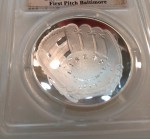
2014 National Baseball Hall of Fame commemorative proof dollar graded by PCGS PR70
Resigned to the fact that the U.S. Mint once again failed to meet market demand, I ordered a proof dollar and half-dollar online. I also made sure my order was for more than $75 so that I can get one of the U.S. Mint reusable bags. I can use the bag to transport items to and from my coin club meetings.
The fact of the matter is that after last year’s failure of the Girl Scout commemorative coin to sell the minimum necessary for the Girl Scouts to benefit, it looks like the National Baseball Hall of Fame commemorative may be a home run. What would be a grand slam is that there were rumors on the bourse floor that the U.S. Mint was going to ask congress to update the law so that they can produce more coins. In the current law (Public Law 112–152 [PDF]), the U.S. Mint is limited to producing 50,000 $5 gold coins, 400,000 $1 silver coins, and 750,000 half-dollar clad coins.
If congress raises the mintage limits for the National Baseball Hall of Fame commemorative, it may be the first time they do so for any commemorative coin. Based on a search of online records with the Government Printing Office, there is no record of a modern commemorative coin (since 1982) having its mintage limits increase.
A sellout of these commemoratives would be good for the National Baseball Hall of Fame and Museum. According to the law, the National Baseball Hall of Fame would receive $35 for each gold coin sold, $10 for each silver dollar, and $5 for each half-dollar. If there is a sellout, the Hall of Fame stands to make $9.5 million. That would buy them over 63,000 dozen baseballs, 950,000 Louisville Sluggers made from ash, or more than 12,000 baseball fields using FieldTurf with some money left over for maintenance. Now that’s a lot of baseball!
Mar 21, 2014 | coins, commentary, eBay, legal
 The Ninth Circuit Court of Appeals upheld the dismissal of the antitrust class action suit against eBay for its policy for listing certified coins for sale.
The Ninth Circuit Court of Appeals upheld the dismissal of the antitrust class action suit against eBay for its policy for listing certified coins for sale.
The story begins in 2007 when eBay began to set standards for listing coins on its site. As part of its decision as to which coins could be listed as graded with their grade as part of the listing, the policy was created that grading services had to have been rated good or better in the 2006 Grading Services Survey performed by Professional Numismatic Guild and Industry Council for Tangible Assets.
After a lot of protest from the numismatic community, by 2008, eBay changed their policy for listing coins to require coins worth more than $2,500 to be graded and listings that mention grades be graded by an approved grading service. To become an approved grading service the company has had to grade 50,000 pre-1956 coins, provides an online population report, has three professional graders on staff with at least one a member of the Professional Numismatic Guild, provide a written guarantee, encase coins in a tamper resistant holder with anti-counterfeiting measures, and provide an online serial number verification service.
Initially, only coins graded by Numismatic Guarantee Corporation and Professional Coin Grading Service qualified under these rules. Shortly before the ruling was to take effect, ANACS and Independent Coin Graders make the necessary adjustments to have coins in their holders qualify for listing as graded on eBay.
Universal Grading Service (UGS) was a nascent New Jersey-based grading service decided to file an antitrust suit eBay, the American Numismatic Association, then ANA President Barry Stuppler, and PNG claiming that the rules are preventing them from competing in the market. Their claim was that coins in their holders were allegedly banned by eBay claiming that by using the study, eBay was in collusion with the ANA and PNG to prevent them from participating in the market, an alleged violation of the Sherman Antitrust Act.
UGS initially filed the anti-trust case in the Eastern District of New York. The court, based in Brooklyn, determined that since eBay was the lead defendant and the service most impacted by the suit, New York was not the proper jurisdiction. The court ordered that the case be transferred to Northern District of California.
The case was move to the San Jose Division for the Northern District of California and assigned to Judge Ronald M. Whyte. In mid-2011, Judge Whyte granted motions (with prejudice) to dismiss the case against the ANA, PNG, and Barry Stuppler. That left only eBay as the lone defendant.
On January 9, 2012, Judge Whyte granted eBay’s motion to dismiss the case with prejudice. Judge Whyte noted that the case was flawed from the beginning and gave UGS every opportunity over two years to amend the case in order to prove their claim. Judge Whyte agreed with eBay that USG did not provide evidence that eBay violated the Sherman Antitrust Act or other associated laws.
UGS appealed to the Ninth Circuit Court of Appeals saying that Judge Whyte wrongly dismissed the claim and that they met their filing responsibility under the Sherman Antitrust Act and associated state laws. The three judge panel affirmed the Judge Whyte ruled properly and let the dismissal stand.
UGS, who has ceased operations, can appeal the case to the full Ninth Circuit asking for a review. When appealing a ruling to a full circuit court panel, all nine judges assigned to that circuit, including the members of the three-judge appellate panel, will hear the appeal. An attorney familiar with Federal Circuit Courts said that it is rare that a dismissal by a federal district judge that is upheld by an appeals panel will be selected to be heard by the full circuit. He did note that stranger things have come out of the Ninth Circuit and it could be possible that they would hear the case.
After the Ninth Circuit, the next step would the Supreme Court. Sources report that if the full Ninth Circuit refuses to hear the case or the dismissal is upheld, “there is no attorney in his right mind” that would file an appeal to the Supreme Court after two courts uphold a dismissal.
With this ruling, the Universal Grading Service is effectively dead and buried. Whatever the people behind UGS were hoping to get out of this case will not be realized.
One thing this ruling says is that the cost to entry the coin grading market is very high. The court affirmed that eBay can set the market rules and as one of the dominating venues for selling coins, a new grading service would have to meet eBay’s requirements in order to gain market acceptance. The difficult benchmark is to have graded 50,000 pre-1956 coins.
There appears no reason why pre-1956 was picked as the dividing line. For many, it would make sense to select pre-1965 to include all coins that are pre-clad coinage. Calls to eBay to obtain clarification about the policy have not been returned. Since eBay consulted with John Albanese, principal of Numismatic Consumer Alliance and Certified Acceptance Corporation (CAC), contacting him may be an option.
Interestingly, if eBay is to follow its policy to the letter, coins that received verification stickers from the CAC cannot be listed as part of the grade. Titles should not be allowed to indicate that the coins have been verified by CAC nor should the description. As far as I am concerned it would be acceptable for eBay to ban the designation of CAC verification as I am not a fan of the service.
Which raises a thought: considering the CAC’s business model includes only coins certified by NGC and PCGS, and given Albanese’s past associations with both of those services, if the case was limited to eBay and Albanese/CAC would it have been more successful?
Mar 20, 2014 | celebration, coins, news
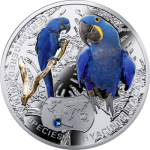
Niue 2014 One Dollar Hyacinth Macaw—Endangered Species of Animals ½ Oz Proof Silver Coin
For those of us in the United States, this has been a brutal winter. Whether you have been buried in snow, had to endure droughts that have not been seen in over 100 years, or record cold temperatures, there are many who would like to forget this past winter. Then there are people like me who would like to see their snow measured in feet and not inches!
Whatever your feelings are regarding the Vernal Equinox, it officially occurred at 4:57 PM UTC (or 12:57 PM on the United States east coast). Maybe you can try the semi-annual tradition of balancing an egg on its end. Good luck!
Mar 19, 2014 | coins, dollar, medals, US Mint
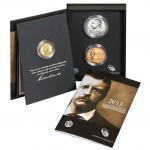
2013 Theodore Roosevelt Coin and Chronicles Set
After receiving the email, I could not remember what I ordered from the U.S. Mint that they are charging my credit card? I remember I made my annual order of presidential coin covers, but I received those. A visit to the U.S. Mint’s online catalog jarred my memory to remembering that I ordered the 2013 Theodore Roosevelt Coins and Chronicles Set. A quick visit to the webpage noted that the items will be available for shipping on March 18, 2014. I received the notice on March 18, 2014. This means the set should arrive within a week!
I usually do not buy the Coins and Chronicles sets because the subjects do not interest me. However, I have always been a fan of Teddy Roosevelt. My first exposure to Roosevelt was as a youngster growing up on Long Island, I was fortunate to have taken a few field trips to Sagamore Hill, his home in Oyster Bay, New York. My other exposure to TR was visiting the memorial to him at the American Museum of Natural History on Central Park West in Manhattan. Every time I go to the AMNH, which still my favorite museum, I make sure I stop in the TR Memorial.
Roosevelt initiated the “Golden Age of American Coin Design.” Using his bully pulpit, he held the designs of the U.S. Mint Chief Engraver Charles E. Barber in contempt. In fact, Roosevelt had called Barber’s designs “atrociously hideous.” Roosevelt ordered coinage whose designs were more than 25 years old to be redesigned. Roosevelt was a fan of sculptor Augustus Saint-Gaudens and asked him to help redesign American coinage.
After Saint-Gaudens died of cancer, Roosevelt continued to look to revitalize U.S. coinage. He seized upon Abraham Lincoln’s 100th birthday to redesign the small cent. He was steered to Victor David Brenner, whose bust of Lincoln was used as the model for the new Lincoln Cent first issued in 1909. Not only was Lincoln the first president to appear on a circulating coin, but Brenner’s obverse design is still in use today.
Roosevelt called his coinage redesign his “pet crime.”
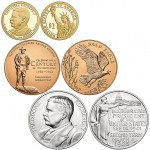
The coins and medals that are part of the 2013 Coins and Chronicles Set
If you want to learn more about our 26th president and have the time to read three books that were writing in Victorian-era prose, I would highly recommend the three books by Edmund Morris: The Rise of Theodore Roosevelt that covers his life up until his presidency, Theodore Rex about his presidency, and Colonel Roosevelt that discusses his life after he leaves office in 1909. For those who want a little lighter reading and in one book, I recommend Mornings on Horseback by David McCullough.
I have not yet read The Bully Pulpit by Doris Kearns Goodwin that covers the era of Roosevelt and his successor, William Howard Taft. Between Roosevelt and Taft, it was a time of bridging the Victorian era with the industrial age. It was a very interesting and important time in U.S. history.
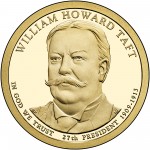
2013 William Howard Taft $1 Coin
For those in need of a good trivia question, Taft was the last president with facial hair, sporting a very cool looking handle-bar mustache.
All images courtesy of the U.S. Mint.
Mar 15, 2014 | ANA, commentary, technology
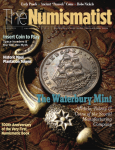
March 2014 edition.
Once you open your copy, you might want to check out the article on page 67. It is written by your favorite numismatic blogger talking about the work being done by the ANA and the Technology Committee on the new ANA website.
Please read the article, but I want to reiterate two points:
- The technology committee is made up of ANA members who are volunteering their time and expertise to ensure that everything regarding the building of the website is in the best interest of the ANA. Long time readers know that aside from my background in information security, I had been a critic of how the ANA was technologically unsophisticated. They benefit by bringing in members, especially those of us who have been critical, to help them move forward in a way to best benefit the organization.
- The work being done by the ANA staff in Colorado Springs has been tremendous. First, it was a great idea by then Executive Director Jeff Shevlin to hire (the now defunct) Amos Digital to really kick start the process. Amos Digital did an excellent job helping the ANA manage the request for proposal (RFP) process and coordinating the review and selection process. It is unfortunate that Amos Press disbanded Amos Digital because they had a great team.
Since becoming Executive Director, Kim Kiick has really done a wonderful job in working with the Board, the Tech Committee, and the selected vendor. In fact, Kim and her staff has worked so well with the new vendor that they have found additional cost savings while maintaining the standards we techies want to ensure is maintained throughout this process.
Writing an article for The Numismatist is more difficult than a blog post because of space limitations. There is only so much that can be said in a limited amount of space. Since I do not have those limitations here, I want to take the opportunity to praise the work of the one person who has really done a tremendous job for the ANA.
For those who do not know, Jake Sherlock is the magician behind the scenes making the cobbled together technology work in trying to make the ANA appear technologically friendly. From helping to maintain the website whose software is sorely out of date to figuring out how to broadcast meetings from the ANA convention, Jake has worked hard with very little to do a lot for the association.
What makes this even more awe inspiring is that Jake does not have a technical background. I am sure he will correct me, but I think he told me his background is in communications and public relations. He should be commended by everyone associated with the ANA for stepping into this role and making a big difference.
Once the new technology is in place it will be fun to see what Jake can do with modern tools.
Thank you, Jake!
Mar 13, 2014 | coins, news
We do not follow maps to buried treasures and X never ever marks the spot.
Professor Indiana Jones could have been talking to coin collectors in 2014 instead of his 1940s-era archaeology class at the mythical Marshall College in “Indiana Jones and the Last Crusade.”
Those watching the coin-related news on both sides of the Atlantic Ocean (“the pond”) may have noticed that finding buried treasure appears to be a consistent theme. Even though some dealers and grading services have complained about the lack of fresh inventory to excite collectors, could new era of coin collecting be fueled by treasure hunters?
This week, Stack’s-Bowers announced they have been searching through a hoard they call the West 57th Street Collection. Stack’s has reported that the 30-ton hoard could be worth $15-20 million and includes coins of all types including nearly 10,000 1909 VDB Lincoln cents. Coins will be sold by Stack’s-Bowers via their online auctions with the rarities being sold at their larger events like the auction at the Whitman Baltimore Expo and American Numismatic Association World’s Fair of Money.
Two weeks ago, Kagin’s made public the finding of the Saddle Ridge Hoard, a hoard of 1,427 gold coins found in cans buried under a tree somewhere in California. Although the names of the finders of the coins is being kept secret, it was reported that the tin cans filled with 19th century gold coins were found by a couple walking their dog.
A man from Victoria Island, British Columbia found an English shilling from around 1551 using a metal detector. It is the oldest coin found on the west coast of Canada. Local experts theorize that the coin was brought to the area by Sir Francis Drake who was sent on a secret exploring mission in 1557. Allegedly, Drake gave the coins to the native peoples as proof the English laid claim to the land. The man who discovered the coin is recently retired who took up metal detecting hunting as a new hobby.
Another metal detector enthusiast in found a 1700-year-old Roman gold coin in Wiltshire, England. The coin was struck for Emperor Licinius I in AD 313 and struck in Trier in Germany, the site of the main mint of the western Roman Empire. The coin was to be sold at auction in December somewhere in London and estimated to bring £30,000 (approximately $48,000). Unfortunately, there have been no follow-up news reports regarding the sale of this coin.
In June 2013, it was revealed that a man found 159 gold coins 20 minutes into his first ever outing with a metal detector. The hoard was found in a field near St. Albans in Hertfordshire, England buried about 7-inches below the surface in October 2012. Publicity for the hoard came on the day a formal inquest was held to determine the ownership of the coins as required by British law. Inquests are publicly announced so that claims may be made. Anyone who can prove a legal claim to the hoard may challenge the ownership. As with most cases of ancient coin finds, only the press comes to gawk at the new found fortune.
What makes this a remarkable story is that the man who found the coins was 20-mintues into his first metal detector hunt. Not sure he wanted to take up metal detecting as a hobby, the man purchased a low-end model recommended for people exploring the hobby or families doing casual metal detecting. For this man, it paid off when he found an ancient Roman solidus estimated to be about 1,600 years old just 7-inches below the surface. The hoard is estimated to be worth £100,000 (approx. $156,000).
With the exception of the West 57th Street Hoard, the other treasures were accidental finds. Whether you are a couple out walking your dog or taking your metal detector out for the first time, it appears that buried treasure still exists.
This does not even account for the finding of sunken treasure like the $77 million of silver found Odyssey Marine discovered at the bottom of the Atlantic Ocean in July 2013. The silver was found on what is supposed to the British steamship SS Gairsoppa, a ship that was sunk by a torpedo from a German U-boat while transporting the silver from England to India in 1941. As with most large finds, this discovery is tied up in court proceedings.
Does this mean that there are no treasures for others to find? That is difficult to say because we do not have maps and, with the exception of the movies, X does not mark the spot.
If you want to try to find a treasure, you need to consider what the world was like in years past and not today. Was the area you are searching once a forest that was not inhabited or was the area that is a park or forest today once a village, town, or small city? Is there a trail that was one a well-travelled trade road or could that trade route be buried under your neighborhood?
A friend who goes out regularly with a metal detector says that most of the finds are not made by dumb luck. Successful metal detector hobbyists take the time to research the areas which they are interested to understand what was once in that location. Before going on a search, they will go to libraries or town halls to look at past records. This gives an insight into what was once in the area they want to search so that they can concentrate their limited time to get the best reward.
Although we are interested in finding coins, metal detectors will find anything metallic including old tools, pottery that was glazed with metal-based enamel, weapons, spent bullets, armament, and anything else made of metal. The friend mentioned above found a lost town in the Midwest. It appears to have been the proverbial waterhole along the railroad, a stop along the tracks for the steam engines to refill their water tanks. The town died after diesel locomotives made the need for a water stop unnecessary. They did find coins but many were unremarkable or common for the period but kept with the town that has been turned into a tourist attraction.
If you decide to do some treasure hunting and find something, let me know. I would love to bring the story to the community.
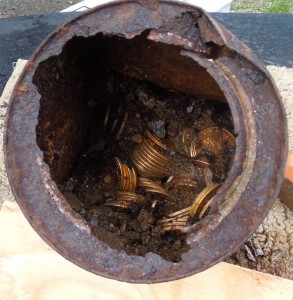
One of the cans found as part of the Saddle Ridge Gold Coin Hoard
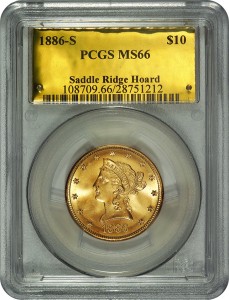
One of the 1,427 “Saddle Ridge Hoard” buried treasure gold coins certified by PCGS.
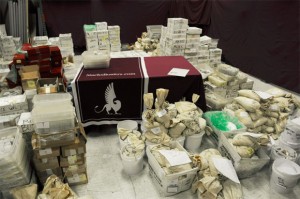
Image of the West 57th Street Collections (Image courtesy of Stack’s-Bowers)
 Computer and online security has been a topic for the news lately. This was because of a mistake made in software that was being used to try to keep your password from being seen by criminal hackers was making it visible to those criminals. In the wake of the news, the Doug Davis of the Numismatic Crime Information Center sent out a message to his list of contacts that had one central message for every dealer and collector:
Computer and online security has been a topic for the news lately. This was because of a mistake made in software that was being used to try to keep your password from being seen by criminal hackers was making it visible to those criminals. In the wake of the news, the Doug Davis of the Numismatic Crime Information Center sent out a message to his list of contacts that had one central message for every dealer and collector:










 The
The 







